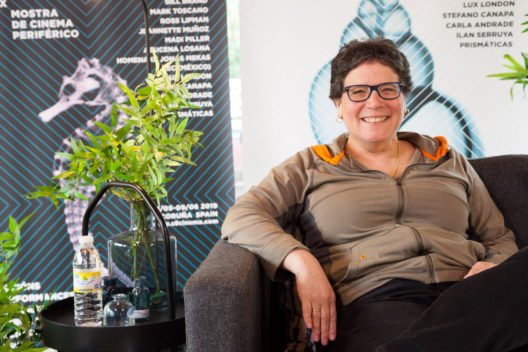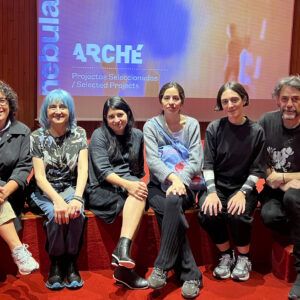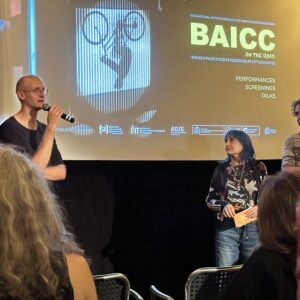
Experimenting with the material and trying to find new images plays a major role in most of your films. Where does that come from?
Well, one looks for a way to express things. I always thought: if you have a camera, and you buy a lens for it, all your pictures will have the same angle. But sometimes you think… I want to go there! I want to achieve that! Then you need a different lens. If you don’t, your possibilities for achieving certain configurations remain unchanged. Instead, I keep trying to figure out: what can I change here to go there? What technique can I use to develop this project? Why am I using this specific technique, this camera, this lens…? I keep experiencing this need to look further, to go one step ahead, maybe because of my interest in technology. When I was in college, I took a class on history of technology and I was totally fascinated. But I’ve had an interest in technologies and mechanics since I was very young.
In your latest films, your experimentation with processes and materials goes together with a research that has to do with memory, with exploring your own roots. How do these two things intersect?
I do explore my personal roots, but it’s true that we live in a large world, and I realise that my family stories or my searching for my own identity have a reflection in the world, they resonate with other people’s stories. At the same time, I don’t think what I’m looking for is unique –it’s an echo of what’s happening in society, in different societies. There’s nothing new, but I rediscover it, and I like to know that I’m also recovering it. There’s a necessity for things to be told and retold. Things that shouldn’t happen again, but that keep happening. That’s why we need to have them constantly present. This is part of my intrinsic needs as an artist, that’s why I’m always looking for an image of light. And it’s something that comes out very naturally. Sometimes I put an image in front of the camera, and it feels too raw: I need to disguise it, I need to put a different window between me and that image, look at it in a different way. That’s when I start using animation.
I’m interested in the process of making The Shifting Sands. You made it with found material, but it intersects with your own family history. Could you go deeper into this?
It all came from a film made by a documentarist –Jacques Madvo. He filmed a lot in different countries. I was working on a commission for LIFT, an organisation for the art in Canada. They had selected different artists, and they asked us to choose a subject. I chose Israel, because I thought that Madvlo’s documentary was to anecdotal, too specific, especially in its approach to history. When you look at the history of this nation, you see it’s a history of loss and division, but also the story of a nation that has kept going on against all odds, and which has constantly been changing its internal policies. I thought it was necessary to review the history of this very young country. There are still a lot of problems in that space, but what inspired me was to recover that documentary and mix it with pictures that my father had taken when he was there after World War II. Making a film like this is quite hard, so I came up with the idea that it could be a hand-processed thing. It was made by imposing the film onto the pictures, copying the documentary with optical printing manually, and mixing it with the photos. It’s a shattered film, just like the Middle East. And I think that putting a lot of thought and reflection on your projects, you might be able to give shape to your film. At least that’s what I do.
We’ll also be screening Not Moldova, 1937, a film where the history of your family is present, too, and which also has to do with WWII. What can you tell us about it?
That is a raw, challenging film, because it takes you into a society that doesn’t recognize the human (or inhuman) mistake that they made during WWII. And it’s something you can tell by looking at those abandoned spaces. I went there a couple of times to explore the space and see what I could find, and basically what you find are abandoned stones. And also that silence, which is also represented in the film. Even the people who helped me there are very young and they completely ignore that part of the history. It’s quite dramatic. More than reuniting with some family history, to me it’s about bringing back a memory that’s been completely forgotten, and that no one is making the effort to recover. Rumania, it’s true, has been trying to join the European Community, and people are more aware of those things, but Moldova, which as republic that’s very close to this country, hasn’t really done anything in that direction. And the film mainly explores the area of Moldavia that was part of the old region of Bessarabia. When I was growing up in Peru, there were so many people that came from Bessarabia that I was convinced it was a country. But it was a province in Rumania. It’s a painful film.
It seems to me that your films, like The Shifting Sands, Not Moldova, 1937, but also Untitled, 1925 have a very political aspect to them.
Definitely. Untitled intends to be a criticism. It involved a long process of going to libraries, and also finding materials outside of libraries –sometimes you can’t even have access to them– in order to find the traces of the immigrants, and in order to find myself, too. I came to Peru to do some research about my grandfather’s journey, but it was also a personal journey to reunite with myself, with the people that are still living there and see me as a foreigner, when the fact is that I still have a heart that was born there, and which, in some way, still coexists with them. Even in the distance, one is able to feel certain connections, and you get there and have this desire to connect with this land again, but you find so many painful things… In Untitled, I chose not to film the outskirts that were in front of the camera, I focused only on my grandfather’s journey in order to avoid all the visual chaos that was taking place. It’s an apparently calm film, but that is strong and shocking because of the words I use. All this chaos is channelled through the poetry, the words I recite, because that was the feeling of that moment. I made another film where I also work on current social and political issues. To me, approaching them is definitely essential, historical, and mnemonic. And cinema is a very good medium to approach them directly.





